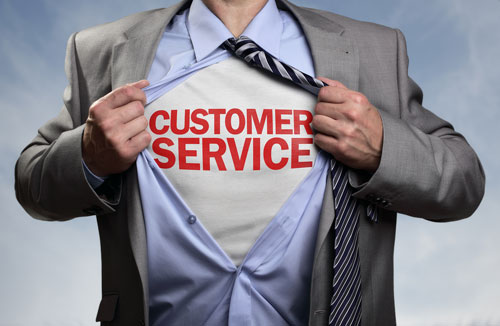
Bryan Horn examines the state of customer service today and provides three ways to reduce customer frustration and promote positive outcomes.
I saw a cartoon in a business publication that accurately sums up the sad modern state of customer service. A woman is speaking into a phone recorder while two men stand behind her. The men are speaking to the woman as she records her voice into the voicemail. The cartoon caption reads, “Next time you say ‘your call is very important to us’, try not to laugh!”
As I have said over and over, many companies adopt a “to big to fail” mentality with negative customer practices to match. In short, companies know they can get away with treating their valued customers like garbage and suffer little to no repercussions. How often have you called a large bank, cable company or other megacorporation only to be handed off from one department to the other?
Every agent then refuses to take accountability for the problem their company created and passes you from one person to another. Frustrated, your anger grows as you explain the situation multiple times. And then, if you’re lucky, the company might take responsibility and fix the issue. More often than not, they will use that dreaded word “unfortunately” coupled with a series of excuses as to why you’re plain out of luck.
Nothing is more frustrating for a customer than having to rehash their problem over and over again to multiple agents. The following example is a true interaction one of my clients had with a large cable provider (name has been changed).
“Thank you for calling ABC Cable Company. How may I help you?”
“Yes, this is Steve. The cable box you sent me arrived defective. I would like a replacement please.”
“Unfortunately, you have reached the sales department. I will need to transfer you to refunds. I will make sure you are transferred to the correct department. Please hold.”
Several minutes of annoying hold music follows until the phone picks up again.
“Thank you for calling ABC Cable Company. How can I help you?”
“Yes, this is Steve. I purchased an item from you and it arrived defective. I need a replacement please.”
“Unfortunately, you have reached technical support. I will need to transfer you to the correct department.”
“But the previous agent said you were the correct department!”
“I cannot be held responsible for the previous agent’s comments. Unfortunately, I am not able to assist. I will make sure you are transferred to the right department this time.”
By now, the blood is beginning to boil as the hold music continues. Another several minutes passes.
“Thank you for calling ABC Cable Company. So I can understand your situation, can you please inform me what is going on?”
“This is Steve. As I have explained twice already, the cable box you sent me is defective. I need a replacement.”
“I understand your frustration. However, we are unable to send you a free replacement. You will need to purchase a new box.”
“But the box is defective. Are you telling me I need to purchase a new box that I already paid for and was defective upon arrival?”
“Yes, that is our company policy.”
Interactions like these are sadly far too common and demonstrate how many organizations have adopted company centric practices versus customer centric ones. In my previous book, I shared a story while senior director of finance within the auto industry. I was calling a large automotive bank to obtain a payoff for a vehicle held in the name of a business.
Normally, this process takes around thirty seconds to perform. But this particular financial institution has enacted practices to make it difficult and frustrating to obtain this information. In this case, it took seventeen long and grueling minutes to obtain information that should have taken less than a minute. I was transferred to seven different departments and placed on hold for a mind-numbing amount of time. Every agent used the “not my department” verbiage and cold transferred me to someone else. The agents would assure me that I would be transferred to the right department this time around. Sure enough, no such luck. When I would reach another agent, I had to explain the problem again. Upon obtaining the information, the customer left and took his business elsewhere. The customer left angry, I was left without a sale, and the financial institution couldn’t have cared less.
It should not be this way, yet is the new normal. Companies have forgotten who keeps them in business. Companies fail to remember their primary mission is to provide products and services combined with amazing experiences for customers. Everything a company does must have one goal in mind: Create moments of “wow” for customers.
Zappos has created a system that empowers employees to handle all issues at one point of contact. Agents are empowered to issue return labels, refunds, upgrade shipping options and send promotional coupons when issues arise. They have broken traditional molds and proven that agents can take care of all customer needs at one touchpoint rather than playing department-to-department musical chairs. This customer centric philosophy is what contributes to Zappo’s success as a company. According to Zappo’s, “we want to distinguish the service experience for every customer, on each and every phone call.”

However, if you must transfer customers to another department, I suggest implementing the following practices to reduce customer frustration and promote positive outcomes:
Speak to the appropriate agent directly. When a customer has reached the wrong department, don’t cold transfer them to another agent and leave them to chance. Place the customer on hold and explain to the next agent the situation that has arisen. Emphasize the customer is frustrated and has been transferred to the wrong department, further adding to their negative experience thus far. By doing this, the new agent is brought up to speed and does not have to ask the customer to restate the problem.
Apologize for the problem. This should seem obvious, but this simple act has been lost in today’s company centric cultures. Apologize to the customer for the incorrect transfer and the problem they are facing.
Resolve the issue and compensate for the mistake. When the customer has reached the correct agent, use reaffirming language that tells your customer you are going to be their hero. In the example from before, had the company been customer centric, the conversation would have been much different. “Hi Steve, this is Linda. The previous agent has informed me of the situation, and I will take care of it. I am sending you a new box via overnight mail, and it should arrive by 5:00 p.m. tomorrow. I am also issuing you $25 credit for the inconvenience experienced today!
Micah Solomon says it best,
Any time someone tells you that “wow” customer service is too expensive, ask them how much they paid on their marketing and sales efforts last year. Creating an emotional connection with your customers is the most direct route to getting your customers to doing your marketing for you.
When you forget that customers are the most crucial part of your business, then it will suffer. I can’t say it any more plain than that. You have the ability to create experiences that will knock the socks off of your customer’s feet. Enact them, enforce them, and improve on them. Think like your customers and put yourself in their shoes. Standards must be consistent across every department, and everyone must be accountable to the customer. When you provide genuine and emotional connections for your customers, you’re not just generating revenue. You are changing the world for the better, one human being at a time.
In the logo for my consulting firm, I use two Japanese characters that spell the word kaizen. It means “good change”, but is also the embodiment of a way of life. Kaizen means to continually look for opportunities to better one’s self and surroundings. What a great concept for customer experience! Even the most customer centric organizations will tell you that they can always do better. That is why we are here, and that is why you are reading this article.
You are presented daily with an abundance of chances to be a hero in your customer’s lives. Put on your cape and make it happen for them!
About the Author
 Bryan Horn is a customer experience trainer and corporate culture development expert. He has 16 years of experience as a financial services manager. He has been homeless, jobless, and everywhere in between. He brings real-world applications and stories that relate to every culture and industry.
Bryan Horn is a customer experience trainer and corporate culture development expert. He has 16 years of experience as a financial services manager. He has been homeless, jobless, and everywhere in between. He brings real-world applications and stories that relate to every culture and industry.
He is the author of the internationally successful book The Customer Service Revolution: 8 Principles That Will Change the Way Companies Think About the Customer Experience and the Employees Who Work for Them. He is currently publishing his second book, Get Your Stuff and Get Out! Why Customer Service Sucks and How We Can Make It Great Again!
Bryan is the founder of CX Solutions, a customer experience training consulting firm. He resides in Salt Lake City, UT.
For more information, please visit www.thecsrevolution.com.





Recently bought a cooker at Lowestoft Branch cannot praise your staff enough especially the young man on the door he made it so easy for me will certainly continue to shop there Well Done !!
I decided to take advantage of a “spend $50 and receive $20 back offer.” After making my purchases (amounting to $76.67). The checkout person told me there was no $20 rebate. I offered to show her the sign in the store but she declined and sent me to customer service. The employee working there finally discovered it was because I did not have a Target app on my phone. After a few tries she finally gave me a gift card for $20. She was not rude but made it clear I was causing her extra work. As we were leaving she said to put the app on my phone for future purchases. I DO NOT WANT TARGET TO HAVE ACCESS TO MY CELL PHONE. After using a Target app does Target then have access to my cell phone #? Do they send out unwanted advertisements? Is it possible to take advantage of your sales and not install the app?